Participate in the critical coastal conversations with experts discussing climate change and coasts in crisis, future of seafood and plastics and marine pollution. Get tickets here or watch the first of series, “Coasts in Crisis: Our Relationship with Rising Seas” by Dr. Kelsey Leonard below.
Category: Engagement
From Pollution to Product: URI Textiles Expert Izabela Ciesielska-Wrobel Works to Weave Plastics into Cloth
She remembers how she felt as she absorbed the enormity of the situation: storm-size gyres of plastics debris swirling upon the world’s oceans. “Terrified,” says Izabela Ciesielska-Wrobel, an assistant professor of the URI College of Business specializing in Textiles, Fashion Merchandising and Design. “It broke my heart.”
So she dealt with it the only way she could – she decided that as a scientist, she needed to start working on a solution, via an area she knows like the back of her hand: textile technology and manufacturing. “I started to think of the plastics problem in terms of what I know, and that’s how it started for me,” says Ciesielska-Wrobel, whose academic career has focused her studies on knitting, weaving, spinning, and non-woven technologies.
A native of Poland, Ciesielska-Wrobel secured her Ph.D. in 2007 by studying how people’s bodies register different fabrics, documenting, for example, the effects that certain textiles can have on body temperature and movement ability. She spent an initial research stint in textile product development in the private sector in Virginia, and was able to achieve textile research funding from the U.S. Department of Energy and the Department of Defense.
She then arrived at URI, and started to pursue in depth her study of ocean plastics. At the core, she says, she felt that textiles technology could play an expanded role in solving this pressing pollution problem. “We already know how plastic PET bottles can be made into fabrics,” she says, “but what if we could use more of other kinds of plastics, and what if we could use these plastics to make other kinds of textiles, for many uses?”
One of her chief interests with this work – she wants to be able to transform plastic waste into filaments, then yarns material, and finally cloth – is to make a durable enough product that could be a base for longer lasting clothes and other household and business items. “We need to be thinking about sustainability,” she says. “We should be thinking about items that last, instead of items that are thrown away and cause more problems.”
But, she indicates, that something easier said than done, as business models today often reflect a dependence on throw-away products. “Wrap2Wear” is the name she has given her in-process technology textiles, and she spends time talking with other scientists, business experts, entrepreneurs, and textile companies to build interest in, and support for, these efforts. And she shares her work with her students, and sees great potential in the next generation to take on ocean plastics and similar problems of the day. “It’s very exciting,” says Ciesielska-Wrobel. “I love working with students, and they have many ideas about this kind of solution to ocean plastics.”
Ultimately, the problem of ocean plastics is a large one – and one that will require expertise from many knowledge arenas to solve. “We have had our wake up call. For me, being able to apply what I know from my work with textiles is the way that I feel I can be most helpful,” says Ciesielska-Wrobel. “But we can all do something. We all have a role to play with this.”
Professor Elizabeth Mendenhall: Propelling Policy for Ocean Plastics
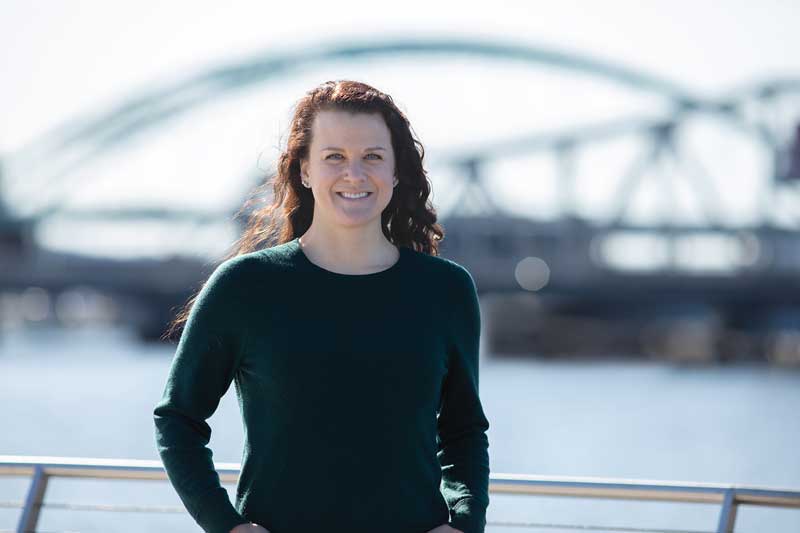
Elizabeth Mendenhall article lays out “A research agenda to propel policy development” regarding ocean plastics. According to Mendenhall, although the phenomenon of marine plastic debris is now widely recognized as a problem for the international community, significant gaps in understanding still inhibit the creation and implementation of effective policy responses. This paper reviews the state of scientific knowledge about the causes and consequences of marine plastic debris, including its sources, pathways, composition, location, and impacts on ecosystems and human activities. Much remains unknown about the large scale impacts of plastic debris on ecosystem functions and human health, among other information gaps. Mendenhall suggests that additional scientific research about the nature, extent, and harms of marine plastic debris could increase the political salience of the problem, and produce urgent and focused attention on the formulation of solutions. She also notes that while many policy responses have been proposed, and even pursued, additional research could assist in the prioritization of the most cost-effective strategies. Finally, Mendenhall offers that the research agenda outlined would support a more detailed and comprehensive assessment of the nature of the problem of marine plastic debris, and inform the creation and implementation of effective solutions.
Taking on Plastics in a Pandemic World

Plastics are chemical compounds that have proven to be inordinately useful for humanity—disposable syringes for example. The problem is, they don’t degrade on a human timescale. And once discarded, they begin breaking down into micro- and nanoplastics and drift into the air and water, becoming virtually impossible to recover.
In 2020, URI Graduate School of Oceanography professor Brice Loose and his team found a disturbing amount of plastic in Arctic sea ice cores collected from floes during an 18-day Northwest Passage Project expedition. Sea ice tends to concentrate everything that is in the water, including nutrients, algae, and microplastics.
The effects of plastic on human health are less well-known, though a new Center for International Environmental Law report suggests exposure to plastics poses distinct toxic risks and intersecting human health impacts ranging from cancer to neurotoxicity, low birth weight, and cardiovascular disease.
Pre-pandemic, there was international recognition of the looming crisis and the idea that we have limited time to impact it in a meaningful way. But COVID-19 increased demand for plastic production. The Economist reports that consumption of SUPs may have grown by 250–300 percent in the United States since the coronavirus took hold, according to the International Solid Waste Association. That includes essential personal protective equipment as well as the return of plastic grocery bags, a boom in e-commerce packaging, and restaurant food packaged in single-use containers for takeout and delivery. In addition, the pandemic has curtailed some recycling programs for SUP bags.
URI students, faculty, and alumni are involved on many fronts and in a wide range of research. As a research university, URI has tremendous value to bring to this global effort.
Read the full article to learn more about URI’s efforts with plastics in every ecosystem.
Surface Science for Plastics Solutions
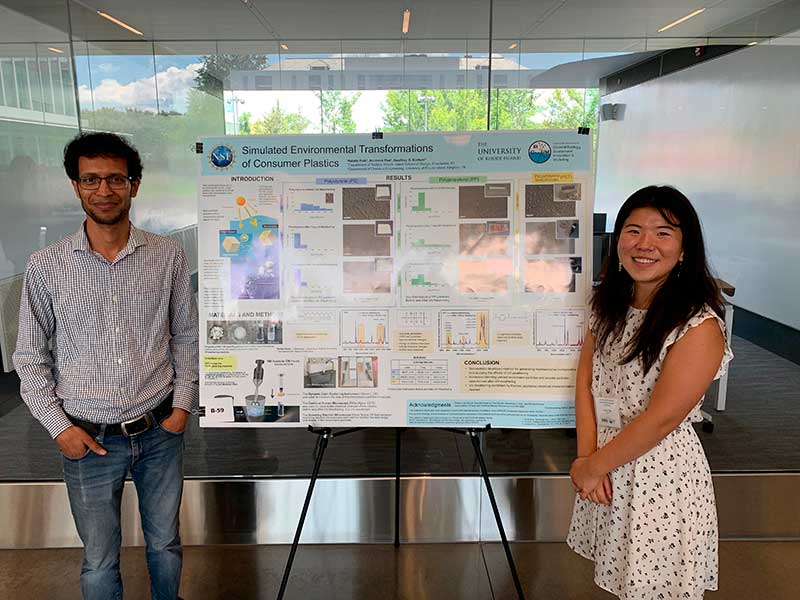
Geoff Bothun, professor of Chemical Engineering and his team were awarded $423k National Science Foundation’s Chemical, Bioengineering, Environmental and Transport Systems grant for the project
“The concentration of small plastic particles in the sea surface microlayer can be much higher than in the underlying water. This is due in part to the transformation of the particles as naturally occurring molecules adsorb onto their surfaces and make them more prone to reside near the air/water interface. There is a significant amount of life that resides near or within the sea surface microlayer and it’s really important that we understand the factors that cause particles to accumulate there,” explains Bothun
Accumulation and transformation of micro- and nano-plastics within the sea surface microlayer. A critical natural component of oceans and a point of initial exposure to plastic pollution are sea surface microlayers, which are ubiquitous globally and are comprised of natural molecules, particulate matter, and microorganisms.
These microlayers act as an “ocean skin” that influences the exchange of mass and heat between the seawater and the atmosphere. They are also a site of microplastic and nanoplastic accumulation. This project will study how microplastics and nanoplastics interact with model sea surface microlayers, how these interactions cause them to accumulate and transform at the sea surface, and to what extent microplastics and nanoplastics will alter the properties of sea surface microlayers.
The goal is to provide fundamental insight into interfacial and colloidal properties leading to microplastic and nanoplastic accumulation that can contribute broadly to determining environmental risks of plastic pollution and to devising strategies for remediation.
Swimming in a sea of polyester: Martin Bide TedxURI talk
Journey through the history of textiles, its value to society and its impact on the environment with URI’s textile chemist, Martin Bide. Consider questions like… how many t-shirts do we really need? Did you buy local? Will it last you the next ten years? Or more?
“Chasing the Wave” of Plastics
Join URI Students Jael “Zippy” White ’21 and Laura Weick ’20 on a visual exploration of plastics pollution; along the way they check in with experts, like URI’s Assistant Professor Coleen Suckling and Associate Professor Andrew Davies, for their perspectives on the problem.
The World is Their Oyster, Thanks to Fulbrights
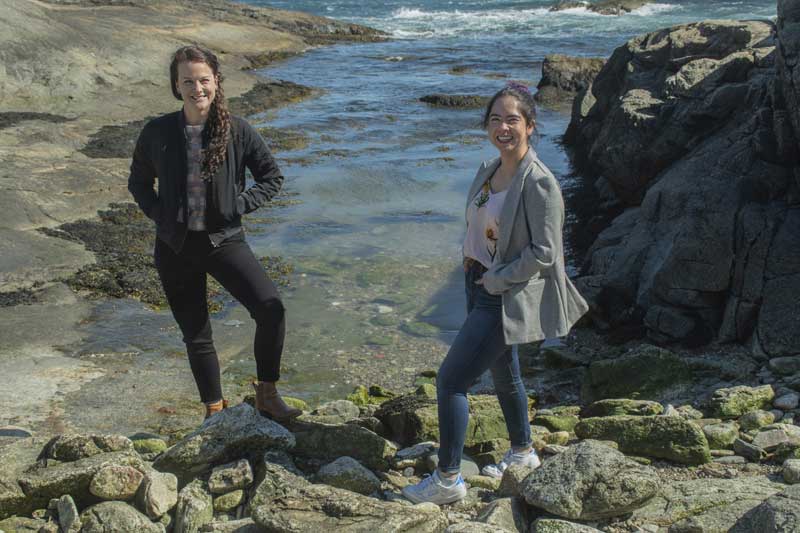
“We talked about the Fulbright together, we learned about it together, and we got excited about it together,” said Mendenhall.
The Fulbright Scholar Program and Fulbright Student Program are designed to increase mutual understanding between the people of the United States and the people of other countries by providing faculty and high-achieving students with opportunities to research, study or teach abroad.
Mendenhall will travel to Iceland for six months beginning next January to teach classes about the law of the sea at the University of Akureyri and to study how a small nation like Iceland has such an outsized influence on international ocean law. She plans to interview government officials and review the national archives to examine Iceland’s influence over international fisheries and whaling policy, its claim of national jurisdiction well beyond the 200 miles offshore that most nations claim, and its role in international relations.
Baron Lopez, who grew up in Monterey, California, will use her Fulbright scholarship to spend 10 months studying South Korea’s strategies for managing marine litter. Beginning in August, she will collaborate with researchers at the Korea Institute of Ocean Science and Technology on a variety of projects designed to better understand the success of various methods of reducing plastics pollution in nearby waters.
Baron Lopez became interested in plastic pollution while attending a lecture at Monterey Aquarium when she was 12 years old. She enrolled at URI after learning that Mendenhall had referenced South Korea’s plastic pollution abatement methods in a research paper about plastic policy development.
Real Science, Real Experience for Coastal Fellows
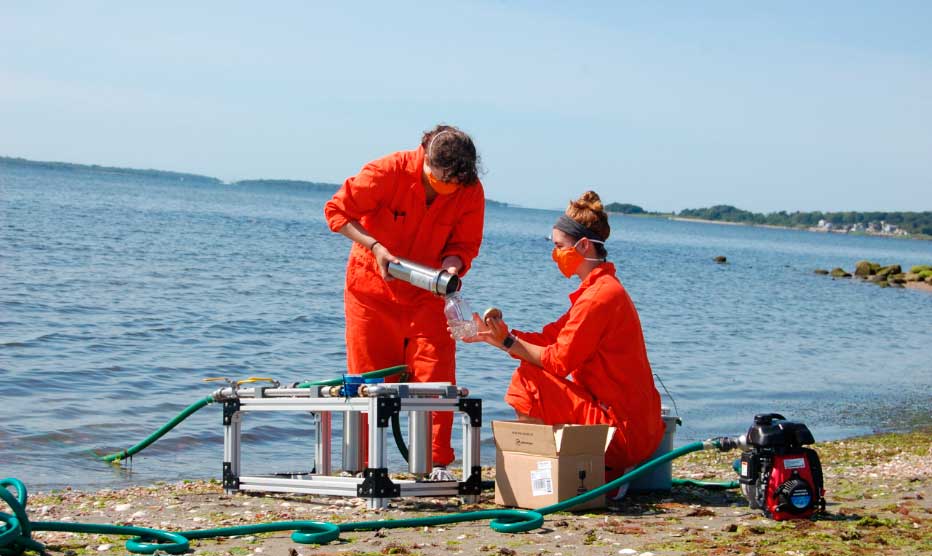
Jacqui Roush and Cara Megill, a senior marine biology and chemistry major from Boyertown, Pennsylvania, found microscopic pieces of plastic at every site they tested – coastal locations from Point Judith to Providence as well as at sites in the middle of the bay. The took their samples back to Coleen Suckling’s laboratory on URI’s Kingston campus to filter out non-plastic particles, and they are now analyzing each sample to see if they can identify the source of the plastic and how it got into the bay.
It’s a process they repeated almost daily from mid-July through August at a dozen sites around Narragansett Bay as part of a research project to document the location, concentration and movement of microplastics in the bay. With the help of Save The Bay, the students also deployed a manta-trawl net from a boat to skim for plastics at the water’s surface.
The students’ plastics research is supported by Rhode Island Sea Grant and the URI Coastal Fellows program, a unique initiative designed to involve undergraduate students in addressing current environmental problems. Now in its 24th year, the program pairs students with a mentor and research staff to help them gain skills relevant to their academic major and future occupations.
The project was a great hands-on learning experience for students about “about microplastics and about the research process in general.” It gave students field and lab research experience to help inform their careers.
Ice Tells the Plastics Story Too
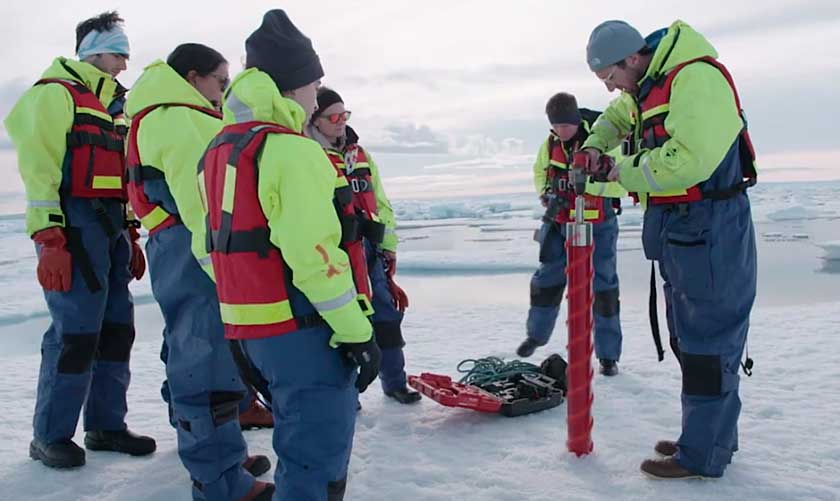
A research team, led by URI’s Graduate School of Oceanography, traveling as part of the National Science Foundation funded Northwest Passage Project (NPP) to investigate the Canadian Arctic Archipelago, discovered a variety of plastics in the sea ice cores collected from floes in the Passage. The team of natural and social scientists, supported by 25 post-secondary students from the U.S. and Canada, were collecting water, ice and air samples as part of the NPP to better understand the impact of climate change on the Arctic environment and biological diversity in the Passage. Over the next few months, the scientists will be analyzing the wealth of samples and data they collected at sea.
According to Brice Loose, URI associate professor of oceanography and the expedition’s chief scientist, the team found a disturbing amount of plastic – different types, sizes and colors – in ice cores collected along the ship’s route. Since 2014, it’s been known that plastic has been appearing in sea ice in the Central Arctic, Beaufort Gyre and the Eurasian Basin. However, this is the first time the presence of plastics has been discovered in ice – both multi-year and first-year ice – from the Northwest Passage.
Building on the research of colleagues who had been looking at the existence of plastics in the Central Artic, the NPP team collected plastic from ice floes that were up to about 8 feet in thickness. Some of the sea ice collected is believed to have started out in the Central Arctic, moving east through the Nares Strait by Greenland, and then making its way into the Passage’s Lancaster Sound last year.
The collected samples reinforce the observation that ice concentrates microplastics, which are found in a much greater abundance than in an equivalent volume of seawater. This may impact the structure of the ice and its absorption of solar radiation as well as the interaction of plastic particles with microorganisms, phytoplankton and zooplankton. While these potential relationships have not yet been established for sea ice covered regions, the sheer quantities of microplastics found does underscore how manmade waste is impacting the environment – even in more remote, sheltered locations such as the Arctic.

